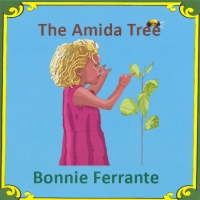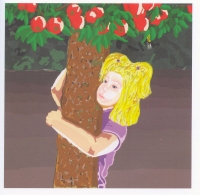| ________________
CM . . .
. Volume XX Number 36. . . .May 16, 2014 
 |
The Amida Tree.
Bonnie Ferrante.
Thunder Bay, ON: Single Drop Publishing, 2014.
28 pp., pbk., $8.99 USD on Amazon.com.
ISBN 978-0-992103-73-6.
Grades 3 and up / Ages 8 and up.
Review by Dave Jenkinson.
*** /4
|
| |
|

excerpt:
As the girl grew, she watched blue damselflies flap their bright wings.
“I want to buy a microscope to see the smallest things,” she told the tree. [sic] May I pick your apples and sell them?”
“Some, but not all,” said the tree. “Many eat my apples. White-tailed deer, black bears, red foxes, and even little rabbits. Take a few and perhaps a better idea will come to you.”
Like Robert Munsch’s Love You Forever, Ferrante’s The Amada Tree is a book that will be more enjoyed and better understood by the adults who are reading the book to children than by the children who are on the receiving end of that reading. Like Love You Forever, The Amada Tree covers a life cycle, but instead of Munsch’s mother/son relationship, Ferrante develops her themes by showing the connection between a child and a wild apple tree.
 On the opening page of text, Ferrante establishes the fact that “A little girl loved a wild apple tree....she knew the tree loved her back.” In the same way that a person will turn to a loved one in time of need, the little girl approaches the tree when she needs to raise money to purchase a microscope [see above excerpt]. The apple tree pushes the girl to think beyond the easy idea of just selling its fruit in its raw state, and the girl responds by making and selling candy apples and by creating wizened applehead dolls from the tree’s fallen fruit. When the girl’s sales provide enough monies to buy not just the microscope but a chemistry set as well, the girl asks, “How can I show my gratitude?” The apple tree suggests that she plant some of the fallen apples so that “new trees will grow to feed more of the animals.” Not only does the girl do as requested, but she uses her new chemistry set to analyze the soil around the tree and to provide missing nutrients. On the opening page of text, Ferrante establishes the fact that “A little girl loved a wild apple tree....she knew the tree loved her back.” In the same way that a person will turn to a loved one in time of need, the little girl approaches the tree when she needs to raise money to purchase a microscope [see above excerpt]. The apple tree pushes the girl to think beyond the easy idea of just selling its fruit in its raw state, and the girl responds by making and selling candy apples and by creating wizened applehead dolls from the tree’s fallen fruit. When the girl’s sales provide enough monies to buy not just the microscope but a chemistry set as well, the girl asks, “How can I show my gratitude?” The apple tree suggests that she plant some of the fallen apples so that “new trees will grow to feed more of the animals.” Not only does the girl do as requested, but she uses her new chemistry set to analyze the soil around the tree and to provide missing nutrients.
The girl next approaches the apple tree for assistance when, as a young woman, she wants to attend university but lacks the funds to do so. “May I sell your branches as firewood?” the girl asks the tree, but the tree points out that it would be weakened by having its live limbs cut. However, it does make the offer, “Take my broken branches”, adding, “Perhaps a better idea will come to you [than simply selling the dead branches for firewood].” The young woman transforms the branches into animal carvings that she sells, and the wood shavings from her carving she spreads beneath the tree.
A few years pass before the girl, now a woman, returns, and she finds the untended tree in need of being both cut back and fertilized, actions which she carries out. It is at this point that the story has a most awkward transition:
”Look,” said the tree. “The apples you planted have sprouted.”
“How wonderful,” said the woman. “I will use the money from this book I’m writing to travel and tell children the importance of our wild fruit trees.”
Though the woman’s planned globetrotting explains her subsequent long-term absence from the apple tree’s locale, there has been nothing earlier in the story to suggest either that she wanted to be a writer or that she was an advocate for fruit trees.
Picking up the story, readers find that decades have passed and that the aged, weakened tree has succumbed to the weight of a winter ice storm, its trunk splitting. “The largest piece crashed down.” In the spring, the woman, now elderly and bent herself, finds the dead tree. When the old woman articulates that she misses the tree, the trees that she planted decades before respond, “We’ve missed you too.” The woman’s summary statement is one to which we should all aspire: “I’m grateful...that we shared our lives.”
Ferrante uses a conventional design with the text appearing on the left page of each pair of facing pages and with the right page being taken up by a full-page illustration. A blurb on the book’s back cover informs readers that “Bonnie Ferrante was a grade school teacher for thirty-three years. She is a Buddhist Lay Leader, mother, and grandmother.” Ferrante’s teacher past should have prompted her to add some endnotes, with one being used to define the word Amida (which appears only in the book’s title and nowhere else) and to explain its connection to Buddhism. A second note could have been used to explain the symbolic meaning of the black and yellow caterpillar that is first found on the book’s cover where it is perched on the two es in Tree. The caterpillar then reappears in virtually every full-page illustration in the book. Perhaps it was meant as an unstated form of “Where’s Waldo?”, but, since a caterpillar is the larval stage of a butterfly or moth, I suspect its appearance is being used as a “stage-of-life” symbol having a connection to Buddhism.
As noted at the outset, though this picture book looks like it was meant for a young audience, an appreciation of its contents requires more life experience than will be found in the normal picture book crowd. Although not mentioned in the book, Ferrante does have a website (http://my.tbaytel.net/bonnieheather/index.htm). There, clicking on “Bonnie Ferrante’s Writing” leads to a cover image of The Amida Tree. In turn, clicking on the cover brings up more than a dozen “Discussion Questions for Parents and Teachers”, three “Research Questions” and seven “Relevant [Web] Sites”, including one for making apple dolls and another on how to make candy apples. One of the discussion questions [too] briefly answers the question, “Why is the tree called Amida?”
Recommended with Reservations.
Dave Jenkinson, CM’s editor, lives in Winnipeg, MB.

To comment
on this title or this review, send mail to cm@umanitoba.ca.
Copyright © the Manitoba Library Association. Reproduction for personal
use is permitted only if this copyright notice is maintained. Any
other reproduction is prohibited without permission.
NEXT REVIEW |
TABLE OF CONTENTS FOR THIS ISSUE
- May 16, 2014.
AUTHORS |
TITLES |
MEDIA REVIEWS |
PROFILES |
BACK ISSUES |
SEARCH |
CMARCHIVE |
HOME |

 On the opening page of text, Ferrante establishes the fact that “A little girl loved a wild apple tree....she knew the tree loved her back.” In the same way that a person will turn to a loved one in time of need, the little girl approaches the tree when she needs to raise money to purchase a microscope [see above excerpt]. The apple tree pushes the girl to think beyond the easy idea of just selling its fruit in its raw state, and the girl responds by making and selling candy apples and by creating wizened applehead dolls from the tree’s fallen fruit. When the girl’s sales provide enough monies to buy not just the microscope but a chemistry set as well, the girl asks, “How can I show my gratitude?” The apple tree suggests that she plant some of the fallen apples so that “new trees will grow to feed more of the animals.” Not only does the girl do as requested, but she uses her new chemistry set to analyze the soil around the tree and to provide missing nutrients.
On the opening page of text, Ferrante establishes the fact that “A little girl loved a wild apple tree....she knew the tree loved her back.” In the same way that a person will turn to a loved one in time of need, the little girl approaches the tree when she needs to raise money to purchase a microscope [see above excerpt]. The apple tree pushes the girl to think beyond the easy idea of just selling its fruit in its raw state, and the girl responds by making and selling candy apples and by creating wizened applehead dolls from the tree’s fallen fruit. When the girl’s sales provide enough monies to buy not just the microscope but a chemistry set as well, the girl asks, “How can I show my gratitude?” The apple tree suggests that she plant some of the fallen apples so that “new trees will grow to feed more of the animals.” Not only does the girl do as requested, but she uses her new chemistry set to analyze the soil around the tree and to provide missing nutrients.